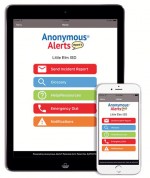In grade school, there are not many instances in which the students know more than the teachers but, T. Gregory Bender said, when it comes to bullying, suspicious behavior or rule-breaking, children are the best informed.
That thinking is, in part, how Bender, CEO and president of White Plains-based Anonymous Alerts Reporting, came up with the idea for an app that allows students to file incident reports and communicate with school administrators while remaining anonymous if they so desire.
“The tradition was to have a locked box in front of the principal”™s office,” Bender said. “I wanted to come up with a mobile way of doing so.”
Since its launch in 2013, Anonymous Alerts has been implemented in 1,500 public and private schools nationwide and serves 1.2 million students.
Anonymous Alerts is used in schools as close to White Plains as Greenwich, Somers, Stamford and North Salem and as far away as Texas and Florida, which has the largest school district at 160,000 students and staff using the app.
The app creates a database of information for school administrators as it receives student reports. Though aspects of the software are designed to be tailored to individual schools ”” school logo, report recipients, report localities ”” it gathers the same basic data across the board: location and time of the reported incident, the administrator chosen to see the report and the type of report, which can range from cyberbullying to self-harm to physical violence to reporting aberrant or alarming behavior.
School officials have access to the reports using a companion app, Anonymous Alerts Incident Management, which can send the recipient a push notification as a report is filed and allow the administrators to view the reports and potentially spot trends.
For example, administrators can pull up charts ”” which the app creates using data supplied by the student users in their reports ”” to see where most bullying incidents are reported.
Both the student and administrator version of the app can also be accessed from a web browser.
Anonymous Alerts cost about $500,000 to develop, Bender said, and was patented June 30. He wouldn”™t elaborate on how much the app costs, but said the license is issued to school districts on a multiple-year subscription basis and the price depends on the size of the school district.
The idea for this app system came to Bender in 2012 when he started researching incidents of violence in schools and found many of them were linked to harassment and bullying of the individuals who later committed the violence.
“We”™d been working on (Anonymous Alerts) for about a year, and then Sandy Hook rolled around,” he said, in reference to the December 2012 mass shooting in which 20-year-old Adam Lanza killed 20 children and six adults at Sandy Hook Elementary School in Newtown, Connecticut before killing himself.
After that, Bender said his team accelerated work on the software and started pitching the idea to school districts.
On Feb. 7, 2013, Dobbs Ferry was the first school district to roll out Anonymous Alerts but, after more than two years of the app”™s implementation, Lisa Brady, superintendent of Dobbs Ferry Union Free School District, said the roughly 750 high school and middle school students who have access to the app do not use it frequently.
“Although we are happy to have the service available, it is not widely used,” she said, adding school administrators receive “a couple of tips each year,” but they are difficult to follow up on because the reports can be anonymous.
The anonymity component is an important part of the app, according to its creator.
“That”™s where I think the beauty of this whole thing is,” Bender said, adding incident reports can be anonymous so children can file them without fear of retribution.
The lack of Anonymous Alerts in Dobbs Ferry may be less about the software”™s attributes and more about the school”™s standing philosophy for reporting troubling incidents.
“It is important to understand we would not expect ”˜a lot”™ of use,” Brady said, because administrators”™ practice is to try to encourage students to report incidents to teachers or principals in person.
Meanwhile, in a neighboring state where the app was made available less than a year ago, there seems to be more commitment to Anonymous Alert.
P.J. Wax, an assistant principal at Westhill High School in Stamford, where the app was implemented in January, said Anonymous Alerts has been useful so far. He said the students are using it and, fortunately, no violent crimes have been reported.
“We wanted to have a safety net in place that was more accessible for our students,” Wax said.
Accessibility was key, he said, because Anonymous Alerts replaced the phone-in hotline system the school previously used.
Westhill is piloting the app for the Stamford district, which may implement it in other schools after more time has been spent using the software.
Bender said the company is looking to expand its product line.
“What we”™re finding is everybody needs a way to track things anonymously to find out where the issues are ”” whether it”™s an employee with a issue or a college kid,” he said. “We”™re building a business here, but we”™re helping kids and averting a tragedy before it happens. And that”™s what gets me and the staff out of bed.”




















